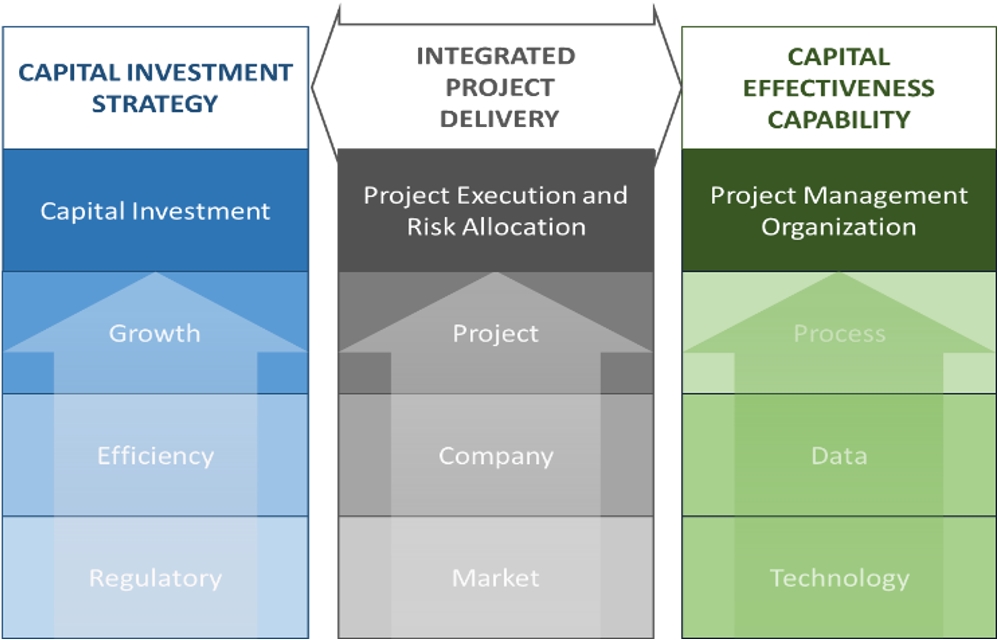
Healthcare Facilities Secret for Success: Project Selection, Speed and Efficiency
Vice President of Strategy and Consulting
Among the myriad of strategic challenges facing healthcare providers in 2017, improving capital effectiveness is emerging as a critical lever for healthcare executives to pull. According to the 2016 Hospital Construction Survey conducted by Health Facilities Management and the American Society for Healthcare Engineering, the cost reductions and efficiency improvements driven by the Affordable Care Act (ACA) are pushing the growth of community based, outpatient facilities and the rapid renovation and expansion projects versus large scale new construction. Developing the capability to select the right projects to fund and deliver them faster and for less capital than competition is the way to maximize an organization’s capital effectiveness.
Capital effectiveness capability is the combination of people, processes, and technology that an organization possesses to evaluate, fund, plan, and execute projects to deliver new and/or improved facilities. Most organizations do not possess the full capability to fulfill all of the design, engineering, procurement, construction, and management requirements necessary to develop and execute projects. To bridge the capability gap, healthcare facilities executives must define a project delivery strategy and execute contracts with architecture, engineering and construction companies. To maximize capital effectiveness and successfully execute a capital investment strategy, the project delivery method must be aligned with the capabilities of the Facilities organization as illustrated in Figure 1 below.

Figure 1. Strategy execution through alignment of capability with IPD.
Nearly a decade ago the American Institute of Architects (AIA) released a guide for Integrated Project Delivery (IPD) to increase the value of capital investment and maximize efficiency through the full project life cycle. At its core, IPD is an approach to project development and execution that “integrates people, systems, business structures and practices into a process that collaboratively harnesses the talents and insights of all participants.” IPD has been embraced by the industry as a superior project delivery strategy for facilities construction. In a recent study conducted by the University of Minnesota, over 80 percent of companies believe that IPD made their projects “better” or “significantly better” across a range of performance metrics. In the continuous drive for further cost, schedule and efficiency improvements, extending the IPD approach to the “internal” stakeholders can deliver capital effectiveness capability.
For healthcare organizations, developing and executing capital projects is not part of the core business. But, the organizations that develop capital effectiveness capability enjoy a distinctive competitive advantage by funding projects that are clearly aligned with strategy and then delivering them faster and more efficiently than the competition. Capital effectiveness challenges present themselves in three primary scenarios that expose an organization’s shortcomings delivering projects effectively. These scenarios are the “Mega Project,” the “Program,” and the “Capital Intensive.” Each presents unique challenges that often result in delays and overruns that erode confidence in investing in capital projects.
- The Mega Project: This scenario is classically defined as a project exceeding $1 billion. But, it applies when any company undertakes a project that is orders of magnitude larger than their typical project. In this scenario, it is the scale, complexity, and magnitude of risk that overwhelms the organization.
- The Program: This scenario is similar to the Mega Project in that it represents a marked increase in capital spend, but it is invested in a collection of projects (like community outpatient facilities) versus a single Mega Project. In this scenario, the collection of inter-related projects exceeds the capacity of the company’s teams, processes and systems.
- Capital Intensive: This scenario represents companies that maintain high levels of capital investment as normal business ranging from tens of millions to billions of dollars. The challenge presented by this scenario is large variability in project performance and persistent cost overruns and schedule delays.
The key to success is to determine what capabilities an organization must develop and maintain to secure that advantage. For each scenario described above, successfully executing a growth or efficiency strategy can be accomplished by aligning the organization’s capital effectiveness capabilities with the appropriate project delivery strategy. This can be accomplished in three straightforward steps:
- Consistently follow project and portfolio management processes that span the complete project lifecycle and seamless turnover to operations, and that integrate with corporate back office functions (e.g. finance, procurement & supply chain, legal, and human resources).
- Develop the project portfolio management skills required to execute the processes and oversee projects. People are the heart of capital effectiveness.
- Maintain an enterprise project management system that enables the processes and organization to manage both the project portfolio and individual projects.
Capital effectiveness capability is readily attainable for healthcare organizations that recognize its value and commit to developing and sustaining the capability as a part of any growth or efficiency strategy. For these organizations, capital projects have an established track record of delivering the value back to the business and investing in capital projects is considered an integral part of the overall corporate strategic planning process. The facilities organization is deeply engaged in strategic planning and it is fully capable of developing and executing capital investment strategies that maximize the value to the overall organization. This capital effectiveness capability is a distinctive competitive advantage and aligning your strategy, capital effectiveness capability, and project delivery is a proven approach to make your company a distinctive leader in healthcare.
Becker’s Hospital Review, a leading publication for hospital and health system business news and analysis, featured this byline in recent articles on facilities management. Read it here.
Michael Matthews is a Vice President of Strategy and Consulting at Enstoa. Connect with Michael on LinkedIn at linkedin.com/michaelfmatthews.
Among the myriad of strategic challenges facing healthcare providers in 2017, improving capital effectiveness is emerging as a critical lever for healthcare executives to pull. According to the 2016 Hospital Construction Survey conducted by Health Facilities Management and the American Society for Healthcare Engineering, the cost reductions and efficiency improvements driven by the Affordable Care Act (ACA) are pushing the growth of community based, outpatient facilities and the rapid renovation and expansion projects versus large scale new construction. Developing the capability to select the right projects to fund and deliver them faster and for less capital than competition is the way to maximize an organization’s capital effectiveness.
Capital effectiveness capability is the combination of people, processes, and technology that an organization possesses to evaluate, fund, plan, and execute projects to deliver new and/or improved facilities. Most organizations do not possess the full capability to fulfill all of the design, engineering, procurement, construction, and management requirements necessary to develop and execute projects. To bridge the capability gap, healthcare facilities executives must define a project delivery strategy and execute contracts with architecture, engineering and construction companies. To maximize capital effectiveness and successfully execute a capital investment strategy, the project delivery method must be aligned with the capabilities of the Facilities organization as illustrated in Figure 1 below.

Figure 1. Strategy execution through alignment of capability with IPD.
Nearly a decade ago the American Institute of Architects (AIA) released a guide for Integrated Project Delivery (IPD) to increase the value of capital investment and maximize efficiency through the full project life cycle. At its core, IPD is an approach to project development and execution that “integrates people, systems, business structures and practices into a process that collaboratively harnesses the talents and insights of all participants.” IPD has been embraced by the industry as a superior project delivery strategy for facilities construction. In a recent study conducted by the University of Minnesota, over 80 percent of companies believe that IPD made their projects “better” or “significantly better” across a range of performance metrics. In the continuous drive for further cost, schedule and efficiency improvements, extending the IPD approach to the “internal” stakeholders can deliver capital effectiveness capability.
For healthcare organizations, developing and executing capital projects is not part of the core business. But, the organizations that develop capital effectiveness capability enjoy a distinctive competitive advantage by funding projects that are clearly aligned with strategy and then delivering them faster and more efficiently than the competition. Capital effectiveness challenges present themselves in three primary scenarios that expose an organization’s shortcomings delivering projects effectively. These scenarios are the “Mega Project,” the “Program,” and the “Capital Intensive.” Each presents unique challenges that often result in delays and overruns that erode confidence in investing in capital projects.
- The Mega Project: This scenario is classically defined as a project exceeding $1 billion. But, it applies when any company undertakes a project that is orders of magnitude larger than their typical project. In this scenario, it is the scale, complexity, and magnitude of risk that overwhelms the organization.
- The Program: This scenario is similar to the Mega Project in that it represents a marked increase in capital spend, but it is invested in a collection of projects (like community outpatient facilities) versus a single Mega Project. In this scenario, the collection of inter-related projects exceeds the capacity of the company’s teams, processes and systems.
- Capital Intensive: This scenario represents companies that maintain high levels of capital investment as normal business ranging from tens of millions to billions of dollars. The challenge presented by this scenario is large variability in project performance and persistent cost overruns and schedule delays.
The key to success is to determine what capabilities an organization must develop and maintain to secure that advantage. For each scenario described above, successfully executing a growth or efficiency strategy can be accomplished by aligning the organization’s capital effectiveness capabilities with the appropriate project delivery strategy. This can be accomplished in three straightforward steps:
- Consistently follow project and portfolio management processes that span the complete project lifecycle and seamless turnover to operations, and that integrate with corporate back office functions (e.g. finance, procurement & supply chain, legal, and human resources).
- Develop the project portfolio management skills required to execute the processes and oversee projects. People are the heart of capital effectiveness.
- Maintain an enterprise project management system that enables the processes and organization to manage both the project portfolio and individual projects.
Capital effectiveness capability is readily attainable for healthcare organizations that recognize its value and commit to developing and sustaining the capability as a part of any growth or efficiency strategy. For these organizations, capital projects have an established track record of delivering the value back to the business and investing in capital projects is considered an integral part of the overall corporate strategic planning process. The facilities organization is deeply engaged in strategic planning and it is fully capable of developing and executing capital investment strategies that maximize the value to the overall organization. This capital effectiveness capability is a distinctive competitive advantage and aligning your strategy, capital effectiveness capability, and project delivery is a proven approach to make your company a distinctive leader in healthcare.
Becker’s Hospital Review, a leading publication for hospital and health system business news and analysis, featured this byline in recent articles on facilities management. Read it here.
Michael Matthews is a Vice President of Strategy and Consulting at Enstoa. Connect with Michael on LinkedIn at linkedin.com/michaelfmatthews.




